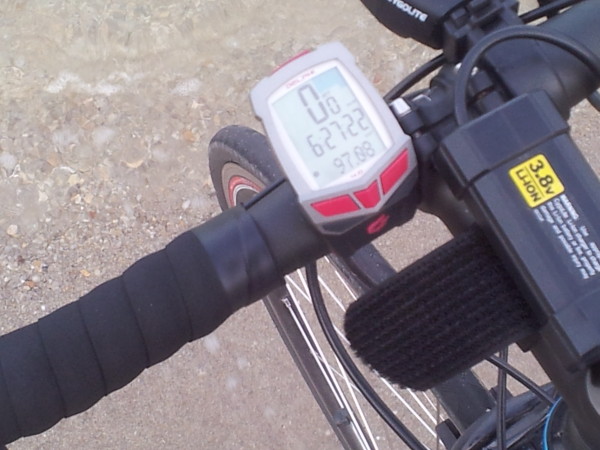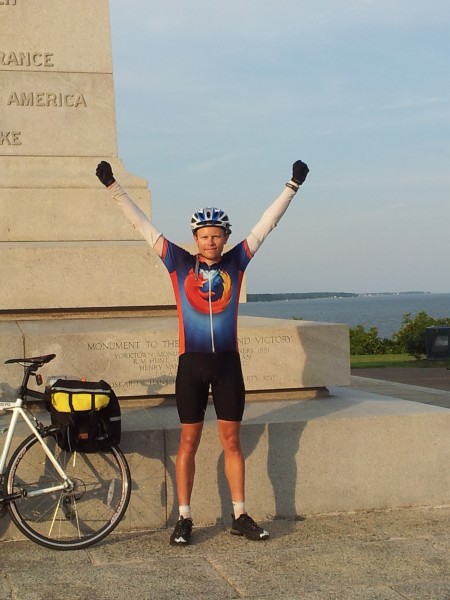This is part two of a series of posts discussing various aspects of a bike trip I did across the United States in 2012. Part 1 discussed the start of the trip and choosing a route. This post discusses my daily routine and where I sheltered each night.
The daily grind
After the first-day snafu, the trip went basically as planned.
I started biking each day sometime in the morning (from as early as 04:00 to as late as 11:45). I finished sometime before or within a couple hours of dark (in the range of 17:00 to 22:00, dependent on my destination) after typical distances of 90-130 miles. Knowing I was on a marathon, I deliberately never pushed for any real length of time. When I hit an uphill, I shifted to the lowest gear that felt comfortable and kept pedaling; I never attempted to power up a hill. And in flatlands I traveled at whatever pace was comfortable, not aiming for speed.
Around home through Bay Area flatlands I usually push myself and average 17-18mph during riding time, depending where and how far I go. On this trip 14-16mph was more common, and I had days well below that. Somewhat hilariously, when I returned I found myself in worse cycling shape by this metric: I was slower than my previous average for awhile, until I could, er, get back into shape. (I also returned well out of shape for playing ultimate frisbee, as I expected would happen from not running and walking little for over a month. When I first played after returning, I had plenty of endurance. But my muscles quickly made it abundantly clear that if I sprinted or made a break, I would hurt myself.)
Shelter
At night I stayed a variety of places. About half the time I camped in a one-man Eureka Solitare tent. (There’s no better 2.5-pound three-season tent out there for its $90 price. Its only demerits are its fiberglass poles [which long ago I was forced to replace with aluminum poles, that have posed no problems] and, occasionally, its not being freestanding.) I slept in a 45-degree bag (too warm!) and a short-length inflatable sleeping pad. These nights were usually in campgrounds, but I stayed in city parks several times in the middle of the country, when allowed. The rest of the time I stayed in motels of varying quality, from $40 to $100+ for the night, sometimes with a meal, sometimes with a pool, sometimes with nothing.
There were a few nights where I neither camped nor stayed at a motel. A local resident of Ordway, CO graciously shared her home with cyclists, and I ended up staying there a night with a couple other cyclists, some heading west, some heading east. The city of Farmington, MO maintains Al’s Place, a hostel for cyclists on the TransAmerica, and I stayed there a night with another cyclist heading east. I also visited The Place, a hostel in Damascus, VA that I’d stopped at while hiking the A.T. And at the end of the trip, in Yorktown, Grace Episcopal Church provided space for cyclists to stay: much appreciated as a base for me to regroup before heading to an airport to fly home.
One additional hostel that I didn’t visit deserves special note. The TransAmerica Trail was first inaugurated in a 1976 mass cross-country ride. One woman along the way, June Curry, put out a sign informing passing cyclists that they could get water at her house if they wanted. One thing snowballed into another, and eventually, somehow, she found herself opening a hostel as a place for passing cyclists to stay, offering much other hospitality as well. Unfortunately June Curry died just before I started my trip, so I couldn’t meet her. 🙁 But I’d heard the hostel would still be open and running when I passed through, and even if it weren’t, it’d be worth a visit just to learn about the place. The day I’d hoped to stay, however, was the day after my longest day the entire way — which meant I’d roll in fairly late, certainly after dark. I tried calling ahead, multiple times, to see if it’d be okay showing up later. But I couldn’t get a response, and after a last attempt before the sun went down, I gave up and went with alternative lodging. 🙁
If my pace were more leisurely, I might have tried out Warm Showers, a site for on-the-road cyclists looking for a place to stay overnight. But as I mostly didn’t know where I’d be til end of day (I set aggressive goals that I didn’t always reach, or only reached late in the evening — see the June Curry story above), the last-minute scheduling seemed way too much hassle for both me and any person who might be willing to host me for a night. It seemed much better to use campgrounds or motels that expect people to spontaneously show up (and more to the point, are specifically paid market rates for it), than to put people hosting mostly for fun through any hassle.
Next time: mileage, elevation, and route scenery.




